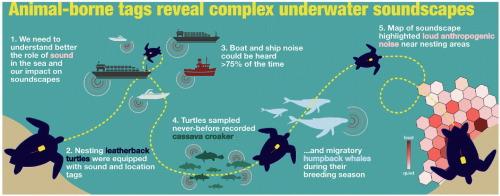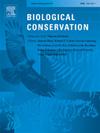Animal-borne sensors reveal high human impact on soundscapes near a critical sea turtle nesting beach
IF 4.9
1区 环境科学与生态学
Q1 BIODIVERSITY CONSERVATION
引用次数: 0
Abstract
Anthropogenic noise (anthrophony) is pervasive in natural soundscapes and has become an important aspect of conservation. While moored sound recorders have aided marine soundscape research, they do not capture the dynamic experiences of animals as they move through underwater soundscapes.
This study used animal-borne acoustic recording tags to capture the marine soundscape near leatherback turtle nesting grounds in Gabon, Central Africa. Propeller noise was heard in 75 ± 14.7 % (mean ± SD) of recordings and peaks in sound intensity up to 146 dB re 1 μPa were detected in shipping noise frequency bands. Loud noise events (> 141 dB), detected in 10 % of recordings, were distributed throughout the turtle interesting habitat. An anthrophony map was created, identifying peaks in noise corresponding with the Komo estuary —gateway to the nation's main international port and near a key nesting area. The pervasive, loud anthrophony recorded in the study may have negative impacts on nesting leatherback turtles and other species of conservation concern found in the area, and warrants further monitoring and management action.
This study offers one of the first spatio-temporal analyses of sound experienced by an endangered marine vertebrate through animal borne, multi-individual acoustic monitoring. It highlights the utility of animal borne acoustic tags in delineating underwater soundscapes and their applicability to studying concurrent biological phenomena and threats, while supporting the need for similar monitoring efforts in other critical sea turtle habitats.

动物传感器显示,人类对一个重要海龟筑巢海滩附近的声音景观影响很大
人为噪音(anthroprophony)在自然声景中无处不在,已成为自然保护的一个重要方面。本研究使用动物携带的声学记录标签来捕捉中非加蓬棱皮龟筑巢地附近的海洋声景。在 75 ± 14.7 %(平均 ± 标准差)的记录中听到了螺旋桨噪声,在航运噪声频段中检测到了高达 146 dB re 1 μPa 的声强峰值。在 10% 的记录中检测到了大噪音事件(> 141 dB),这些事件分布在海龟感兴趣的栖息地。我们绘制了一张人声地图,确定了科莫河口的噪声峰值,科莫河口是通往该国主要国际港口的门户,附近还有一个重要的筑巢区。研究中记录到的普遍、响亮的人声可能会对该地区筑巢的棱皮龟和其他受保护物种产生负面影响,因此需要进一步监测和采取管理措施。这项研究首次通过动物、多个体声学监测对濒危海洋脊椎动物所经历的声音进行了时空分析。这项研究首次通过动物携带的多个体声学监测对一种濒危海洋脊椎动物所经历的声音进行了时空分析,突出了动物携带的声学标签在划定水下声景方面的实用性及其在研究并发生物现象和威胁方面的适用性,同时支持了在其他重要海龟栖息地开展类似监测工作的必要性。
本文章由计算机程序翻译,如有差异,请以英文原文为准。
求助全文
约1分钟内获得全文
求助全文
来源期刊

Biological Conservation
环境科学-环境科学
CiteScore
10.20
自引率
3.40%
发文量
295
审稿时长
61 days
期刊介绍:
Biological Conservation is an international leading journal in the discipline of conservation biology. The journal publishes articles spanning a diverse range of fields that contribute to the biological, sociological, and economic dimensions of conservation and natural resource management. The primary aim of Biological Conservation is the publication of high-quality papers that advance the science and practice of conservation, or which demonstrate the application of conservation principles for natural resource management and policy. Therefore it will be of interest to a broad international readership.
 求助内容:
求助内容: 应助结果提醒方式:
应助结果提醒方式:


